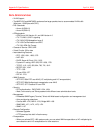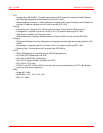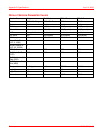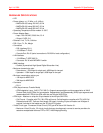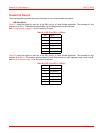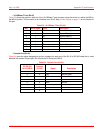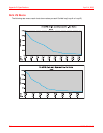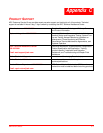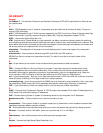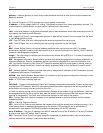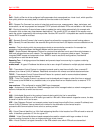
MM70xG2-UM-03 GL-1
GLOSSARY
Symbol
10/100Base-T – The Institute of Electrical and Electronic Engineers (IEEE) 802.3 specification for Ethernet over
thin coaxial cable.
A
AAL2 – ATM Adaptation Layer 2. Used for compressed voice and video that is intolerant of delay. This layer is
used by xDSL technology.
AAL5 – ATM Adaptation Layer 5. AAL5 has been adopted by the ATM Forum from a Class of Service called High
Speed Data transfer. It typically supports all types of data traffic. Originally designed to support TCP/IP.
ADSL – Asymmetric Digital Subscriber Line
ATM – Asynchronous Transfer Mode is a high bandwidth, low delay, connection-oriented, packet-like switching
and multiplexing technique that uses 53-byte fixed-size cells to transmit voice, video and data over a network. ATM
layers define how cells are formatted and provides the transport of the fixed length cells between the modem and
the service provider (or endpoints of the virtual connection).
attenuation – The dissipation of the power of a transmitted signal as it travels over copper wire, measured in
decibels (dB).
authentication – Security feature offered through PAP and CHAP with PPP sessions.
BERBit Error Rate is a measure of transmission quality. The ratio of error bits to the total number of bits
transmitted.
B
bps – bit-per-second is the number of bits transferred during each second of data transmission.
C
CBR – Constant Bit Rate is a Service Class for the modem. It provides constant bit rate data with a timing
relationship between the source and the destination. Also, a traffic class that carries a guaranteed constant
bandwidth. Best suited for applications that require fixed bandwidth, such as uncompressed voice, video and
circuit emulation. CBR is a Quality of Service class defined by the ATM Forum for ATM networks.
cell – A fixed-length packet. Also, the unit of data transmission used in ATM. Each ATM cell contains a fixed-size
frame (53 bytes) consisting of a five-byte header and a 48-byte payload.
community string – A text string required for an SNMP trap to be received by a trap receiver(s). Also, a text string
that identifies an SNMP community and is associated with specific access rights (read-only or read/write).
CRC – Cyclic Redundancy Check is a method used to verify the accuracy of data transmission.
D
DHCP – Dynamic Host Configuration Protocol. A TCP/IP protocol that enables PCs to obtain IP addresses from a
DHCP server that dynamically assigns IP addresses.
DNS – Domain Naming System. A system for translating names of host computers into IP addresses.
downstream traffic – Communications from a service provider to a user.
E
encapsulation – The inclusion of data in a protocol header prior to transmission, which enables successful data
transmission between different protocol networks.
ES – Errored Seconds is the seconds during which errors occur that prevent the payload from being corrected.
Ethernet – A protocol used for LAN traffic, which has a transfer rate of 10 or 100 Mbps.
F
flash memory – Non-volatile memory that can be erased and reprogrammed.
G
G.shdsl – Symmetrical High-Speed Digital Subscriber Line




